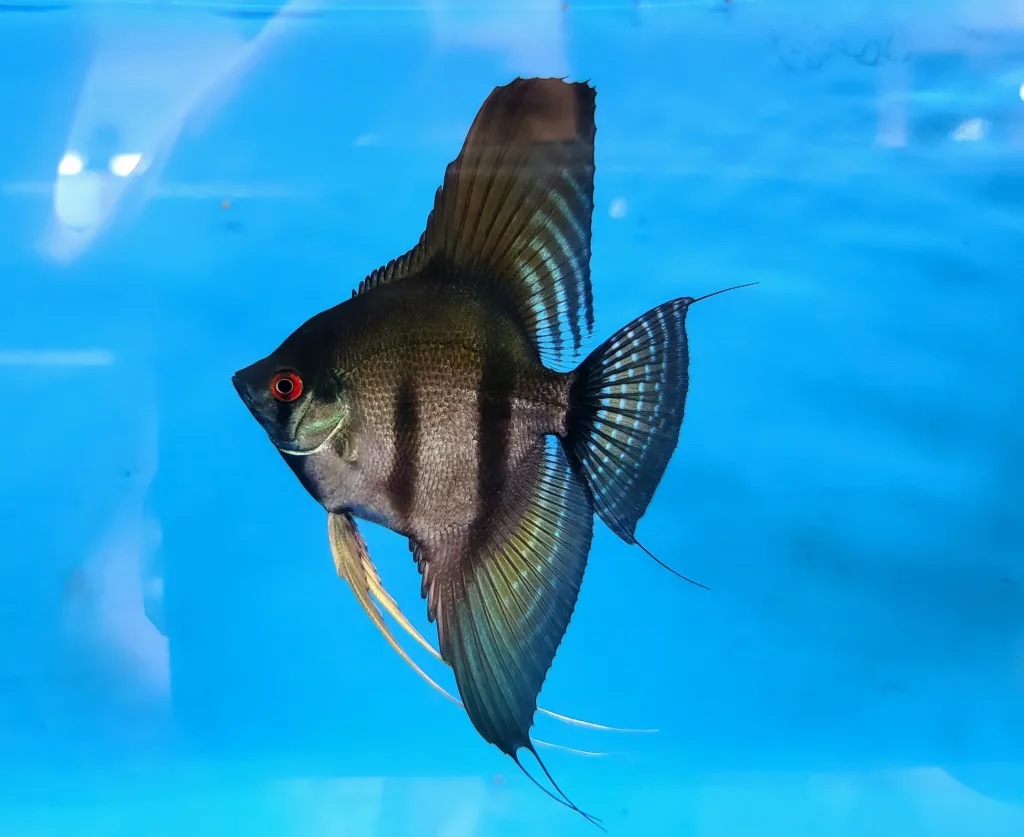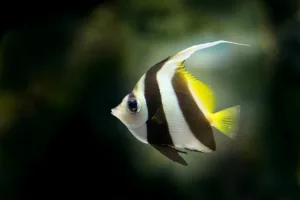Ich, short for Ichthyophthirius multifiliis, is a common parasitic infection that can affect angelfish and other freshwater fish. It’s often referred to as “white spot disease” due to the characteristic white cysts that appear on the fish’s skin, fins, and gills.
Angelfish Ich Symptoms
Identifying symptoms of Ichthyophthirius multifiliis, commonly known as Ich or white spot disease, is crucial for early detection and treatment. Here are the key symptoms to look out for in angelfish:
- White Cysts: The most distinctive sign of Ich is the appearance of small white cysts, resembling grains of salt, on the skin, fins, and gills of the fish. These cysts may look like tiny white spots.
- Clamped Fins: Infected fish may hold their fins close to their bodies, appearing clamped or folded.
- Scratching: Fish infected with Ich often exhibit abnormal behaviors like rubbing their bodies against objects or surfaces in the aquarium. This is an attempt to relieve the irritation caused by the parasite.
- Respiratory Distress: Infected fish may show signs of rapid gill movement or increased respiratory rate, indicating stress and discomfort.
- Lethargy: Ich can cause fish to become lethargic, with reduced activity levels and reluctance to feed.
- Loss of Color: Fish affected by Ich may experience a loss of color or vibrancy.
It’s important to note that the severity of symptoms can vary, and not all infected fish will exhibit every symptom. Regular observation of your angelfish, especially during feeding times, can help you detect any abnormalities early on. If you notice signs of illness, it’s recommended to isolate the affected fish and begin appropriate treatment promptly.
Angelfish Ich Treatment
Treating Ich in angelfish involves a combination of measures to eliminate the parasite and provide supportive care. Here’s a step-by-step guide for effective treatment:
- Isolation: Move the infected angelfish to a quarantine tank. This prevents the spread of the parasite to other fish in the main aquarium.
- Temperature Increase: Gradually raise the water temperature in the quarantine tank to around 86°F (30°C). Higher temperatures speed up the life cycle of the Ich parasite, making it more susceptible to treatment. Maintain this elevated temperature for about 10 days.
- Medication: Use a suitable anti-parasitic medication designed to treat Ich. Common medications include those containing ingredients like formalin, copper, or malachite green. Follow the product instructions carefully regarding dosage and duration of treatment.
- Salt Treatment: Some aquarists opt for salt as an additional treatment. Add aquarium salt to the quarantine tank following the recommended dosage for angelfish. Be cautious with salt if you have sensitive fish or live plants, as not all species tolerate it well.
- Good Water Quality: Ensure optimal water quality by performing regular water changes. Clean water aids in the recovery of infected fish. Use a gravel vacuum to remove debris from the substrate.
- Remove Visible Cysts: If possible, gently remove visible cysts from the fish using a soft brush or cotton swab. This reduces the parasite load on the fish.
- Observe and Adjust: Monitor the fish closely during treatment. If you see signs of improvement, continue the treatment for the recommended duration. If the symptoms persist or worsen, consider consulting with a vet experienced in fish health for further advice.
Remember that consistency and diligence are key during the treatment process. Additionally, avoid overfeeding and ensure that the angelfish receive a balanced diet to support their overall health and immune system.
Angelfish Ich Prevention
Preventing Ich in angelfish and other aquarium fish involves maintaining good overall aquarium health and implementing proactive measures. Here are some prevention tips:
- Quarantine New Fish: Before introducing new fish to your main aquarium, quarantine them in a separate tank for at least a few weeks. This helps identify and address any potential health issues before they can spread to the existing fish.
- Observe New Fish: When purchasing new fish, carefully observe them for any signs of illness or distress at the pet store. Avoid buying fish that show symptoms of disease, as they can introduce pathogens into your aquarium.
- Maintain Stable Water Parameters: Keep the water conditions in your aquarium stable, including temperature, pH, and ammonia levels. Sudden fluctuations in water parameters can stress fish and make them more susceptible to diseases like Ich.
- Regular Water Changes: Perform regular water changes to maintain good water quality. This helps remove organic waste and reduces the likelihood of stress and disease.
- Quarantine Periodically: Even if you don’t introduce new fish, consider periodically quarantining existing fish for observation. This can help catch any potential health issues early on.
- Avoid Overcrowding: Overcrowded conditions can stress fish and contribute to the spread of diseases. Ensure that your aquarium is appropriately stocked based on the size and filtration capacity.
- Proper Feeding: Provide a balanced and nutritious diet for your angelfish. Proper nutrition supports their immune system and overall health, making them more resilient to diseases.
- Temperature Management: Maintain a consistent and appropriate temperature for your angelfish. Ich is more prevalent in cooler water, so keeping the temperature within the recommended range for angelfish can help prevent outbreaks.
- Quarantine Plants and Decorations: If adding new plants or decorations to your aquarium, consider quarantining them separately before introducing them to the main tank. This helps prevent the introduction of potential contaminants.
By adopting these preventive measures, you can create a healthier and more resilient aquarium environment, reducing the risk of Ich and other common fish diseases. Regular monitoring and attentive care are essential components of successful disease prevention in aquariums.
- Angelfish Hex Disease | Treatment, Prevention, Symptoms
- Angelfish Fin Rot | Symptoms, Treatment and Prevention
- Angelfish in the Wild: A Closer Look at These Amazonian Wonders
- Angelfish Myths Unveiled: Separating Fact from Fiction
- Mastering Angelfish Care for Advanced Hobbyists
- Angelfish for Beginners Guide
- Exploring the World of Angelfish and Invertebrates
- Angelfish and Cichlids Compatibility: Finding Harmony in Your Aquarium
How Quickly Does Ich Kill Fish?
The speed at which Ichthyophthirius multifiliis (Ich) can affect and potentially kill fish can vary depending on several factors, including the health of the fish, the temperature of the water, and the severity of the infection. In some cases, the progression of Ich can be relatively rapid, while in other situations, it may take longer.
Here are some factors that can influence the timeline of Ich infestation:
- Temperature: Ich has a faster life cycle at higher temperatures. In warmer water, the parasite goes through its life stages more quickly, potentially leading to a more rapid onset of symptoms and increased severity of the infection.
- Fish Immune System: Healthy fish with strong immune systems may be more resilient to Ich and able to fight off the infection for a longer period. Conversely, fish that are stressed, weakened, or have compromised immune systems may succumb to the disease more quickly.
- Early Detection and Treatment: Quick detection and immediate treatment significantly impact the outcome. If Ich is identified early, and appropriate treatment is administered promptly, it can enhance the chances of the fish’s recovery.
- Strain of Ich: There can be variations in the virulence of different strains of the Ich parasite. Some strains may be more aggressive than others.
- Overall Tank Health: The overall health of the aquarium, including water quality, proper filtration, and a well-maintained environment, can influence the rate at which Ich spreads.
In severe cases, if left untreated, Ich can lead to the death of fish within a matter of days. It’s crucial to monitor your fish regularly for any signs of illness and take immediate action if you suspect an Ich infection. Early intervention and proper treatment increase the likelihood of successful recovery and reduce the impact of the disease on your fish population.
Home Remedy For White Spot On Fish
While there are commercial medications available for treating white spot disease (Ichthyophthirius multifiliis or Ich) in fish, some aquarists also consider home remedies as a supplement or alternative. Keep in mind that these home remedies may not be as immediately effective or reliable as commercial treatments, and their success can vary. If you choose to try a home remedy, closely monitor your fish and be prepared to switch to a proven medication if the condition persists. Here are a couple of home remedies that some aquarists use:
Aquarium Salt:
- Gradually add aquarium salt to the water at a rate of 1-3 teaspoons per gallon, depending on the tolerance of your fish species.
- The salt is believed to reduce the stress on the fish and help in osmoregulation, making it harder for the parasites to survive.
- Ensure that your fish species can tolerate salt, as some are more sensitive than others.
- Do not use iodized table salt, as it may harm the fish.
Elevated Temperature:
- Raise the water temperature gradually to speed up the life cycle of the Ich parasite.
- Maintain a temperature of around 86°F (30°C) for several days.
- The increased temperature accelerates the life stages of the parasite, making it more susceptible to treatment.
- Ensure that your fish can tolerate higher temperatures, as some species may be sensitive.
It’s important to note that while these home remedies might help in mild cases or as part of a comprehensive treatment plan, severe infections often require more targeted and reliable medications available at pet stores or through a vet. Additionally, addressing the root causes of stress and maintaining good water quality are essential for preventing and managing white spot disease in the long term. If symptoms persist or worsen, consider consulting with a vet experienced in fish health for professional advice and medication.
Sources: University of Florida
Disclaimer
The information provided here is for general guidance and educational purposes only. It is not intended as a substitute for professional veterinary or aquarium advice. Fish health can be complex, and individual cases may vary. If you suspect that your fish may be ill or if you have specific concerns about their health, it is recommended to consult with a qualified aquarium professional or a veterinarian experienced in fish health.
Any actions taken based on the information provided are at the user’s discretion and risk. The user is responsible for ensuring the well-being of their fish and should seek professional advice when needed. Additionally, be aware that advancements in research and changes in best practices may occur over time, so staying informed and consulting with experts is essential for responsible fishkeeping.
Remember to follow appropriate safety measures when handling aquarium equipment, water, or any substances used in fish care. Wash your hands thoroughly after any contact with aquarium-related items.
Ultimately, the health and well-being of your fish are of utmost importance, and professional guidance should be sought for specific concerns or conditions.
Disclaimer










